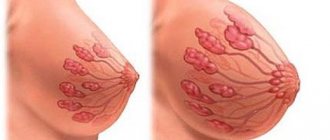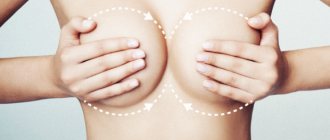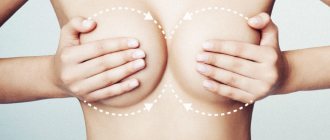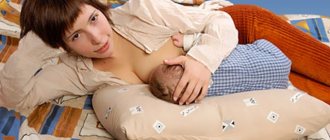Sometimes a nursing mother experiences discomfort and pain in the chest. Unpleasant sensations arise due to a lack or, conversely, excess of milk. The cause of the disease can also be improper feeding, when the baby grasps only the nipple without the areola. Don't forget about comfortable underwear when breastfeeding. An incorrectly chosen bra rubs the breasts and nipples, irritates the skin and causes harm.
The causes of chest pain are stagnation of milk in the ducts, stress and overwork. The article “If your breasts hurt when feeding” will help you identify the exact causes of discomfort and cope with the problem.
Breast massage during feeding can help mom. It stimulates lactation and helps relieve milk stagnation.
Massage during breastfeeding is an optional procedure if the mother does not experience problems or pain when feeding the baby. However, this is an excellent prevention of lactostasis and a safe aid for difficulties during lactation. Massage can be performed already on the first day after the birth of the child.
When should you massage your breasts?
Breastfeeding in itself does not mean that all women should familiarize themselves with proven techniques and conduct a massage session every day, spending a large amount of time on this useful procedure. Most lactation consultants recommend approaching these exercises in the following situations:
- When pumping. At the initial stage, lactation is not stable, sometimes too much milk comes in, and the baby is not ready for such volumes - only sucks out a small part of it. In such cases, a nursing woman may experience milk stagnation as well as mastitis. Expression is necessary, most often by hand, but can also be done using a breast pump. And before the procedure itself, they massage the mammary glands. Milk is also expressed in other cases, for example, during treatment or taking serious medications, or replenishing frozen supplies. Massage stimulating movements provoke the production of oxytocin, which affects the production of breast milk
- To increase lactation. This practice speeds up the blood supply to the mammary glands, which causes a little more milk to come in. For additional stimulation of the mammary glands, you can drink a warm drink - tea or decoction. Relax, rest a little, and then start feeding.
- With stagnation of milk or lactostasis. With the development of such an unpleasant disease, the glands swell, change color, a burning sensation is felt in them, and sometimes even the temperature rises. Frequent latching will help correct the situation, but before feeding you should do a few exercises. Light pressure movements help soften the seals and milk ducts.
- To restore breast shape. Long, full-fledged breastfeeding often leads to stretch marks, sagging breasts, and changes in the skin. But every woman wants to be beautiful and well-groomed. It is massage that will help mothers regain their former elastic breast skin not only after the first birth, but also for women who are breastfeeding their second or subsequent child.
With regular procedures, skin tone is restored, milk production is regulated, and the likelihood of lactostasis is reduced. In addition, light palpation of the mammary glands will help identify formed lumps.
Types of massage
There are two types of massage during breastfeeding: preventive and therapeutic.
Preventive massage during feeding involves lightly stroking the breast. With its help, you can increase the tone of breast tissue and muscles, and also avoid problems with lactation.
Therapeutic massage during feeding is used when necessary:
- improve blood flow;
- increase breast tone;
- and most importantly - to facilitate the process of pumping and eliminate stagnation.
Preventive massage
So, how to do preventive breast massage while breastfeeding to avoid complications during lactation:
- Place your palm on your upper chest.
- Start stroking your breast in a circle, gradually moving towards the nipple.
- Wet your breasts with warm water and continue stroking them. Water improves blood circulation and enhances milk flow.
- Monitor your sensations and the force of pressure on your chest. It shouldn't be painful or unpleasant for you.
On a note! Perform a preventive breast massage before feeding; it stimulates the flow of milk without leading to stagnation.
Massotherapy
If stagnation does occur, proceed to therapeutic massage during feeding:
Place your palm under the collarbone and make light circular spiral movements down towards the nipple. Move your palm from the collarbone to the nipple in straight movements, from top to bottom. Try these movements from different points. Bend forward and stroke your chest
Pay special attention to those areas where compactions are felt - stagnation. Massage them for a minute. Rinse your chest with warm water, or better yet, take a shower
Afterwards, gently pat your breasts dry with a soft towel in a circular motion.
After the massage, you can express your breasts and then give them to your baby. Then the efficiency of suction will be many times higher, and milk stagnation will pass faster.
Therapeutic massage kneads seals well and increases milk production.
Make sure you don't get hurt. The intensity of the massage should be weak, but the duration should be long.
The seals are massaged carefully, do not try to break them.
Attention! Resort to this type of massage only when stagnation has already appeared. In all other cases, perform preventive massage during feeding
In all other cases, perform preventive massage during feeding.
There is another method of dealing with breast swelling during feeding, when it is so full that the baby cannot even grab the nipple.
In this case, it is clear that it and the areola area are tense, and pumping is very unpleasant and painful. Here's how to soften them:
- Place on the area around the nipple, areola, and the fingertips of both hands. Leave the nipple itself free.
- Gently press on the areola, as if plunging your fingers deep into the breast. Nails should not dig into the skin; only the fingertips are involved.
- Apply pressure for 1-2 minutes, then change the position of your fingers to soften the remaining points of the areola. Remember that there is no need to put pressure on the nipple.
- Try applying your fingers differently: place any two fingers parallel to each other and apply pressure.
If everything is done correctly, the areola softens after these manipulations. Now the baby will take the breast easily. Or, if this is pumping, then it will be painless.
Massage has the best therapeutic or preventive effect while feeding the baby. It simultaneously develops the breasts well and prevents milk stagnation.
Important! Proper massage during feeding does not cause pain. Spend five minutes on it
Spend five minutes on it.
There are also situations when you need to refuse massage:
- breast skin dermatitis;
- acute infectious disease;
- stressful state;
- presence of cracks in the nipples.
In such cases, massage during feeding will only worsen the situation and provoke an exacerbation.
If there are no problems with feeding, then you can easily do without breast massage.
If you have problems with feeding, always try to call an in-person lactation consultant. If this is not the case, but you want to breastfeed for a long time and successfully, watch the online course Secrets of Breastfeeding>>>
- Lactation crisis
- How to restore lactation?
- What painkillers can you take while breastfeeding?
Technique for performing massage on the mammary glands
Breast massage for lactation can not only increase milk production, but also affect the health and condition of the mammary glands. Depending on the current situation, a nursing woman should perform certain exercises. After all, incorrect technique for carrying out the procedure can further aggravate the problem. To avoid harm and achieve maximum benefit, massage is done as follows:
- Light stroking around the areola can correct the flow of milk and also help avoid stagnation.
- To enhance lactation, you need to stimulate the entire breast. Using gentle, light pressure, feel all the mammary glands. And if minor compactions are detected, linger at the site of stagnation and massage the damaged area a little longer than usual.
- A number of activities in the shower are considered effective. Warm water stimulates the glands, and massage movements from the top of the breast to the nipple distribute milk in the ducts. To achieve results and increase lactation, the exercise is performed several times on each mammary gland.
- Place your hands on your chest so that the nipple is in the center of your palm. Apply a little pressure on your chest with your entire palm and repeat the exercise up to 10 times.
- Cup your chest with your palm, then draw straight lines to the armpits, then up to the shoulders. Carry out the procedure three times on each side.
- Place your palm under the gland, shake your hand slightly so that the chest “jigs” a little. Do the exercise for about a minute, repeat 3 or 4 times.
- Place your palms together, fingers pointing up, with your elbows bent. Press down on your palms, hold in this position for up to 10 seconds, then relax your hands and repeat the exercise. Do up to 10 approaches.
- Raise your arms to the sides, slowly, counting to 10, raise your arms up. At the same time, cross your arms in the form of scissors at your chest.
- With one palm clasp your chest from below, the other from above. Carry out rotational movements in a circle.
- At the end of the massage session, light stroking of the mammary glands is sufficient.

You can do breast massage yourself, but sometimes, as a last resort, you should seek the help of professionals.
Tools - helpers
Before performing the procedure, apply a little oil to your hands. The following will help improve your results:
- Castor oil - with its help you can calm down the process of inflammation and improve blood circulation.
- Vitamin preparation Aevit - contains vitamins A, E, nourishes, softens and helps restore damaged skin.
- Olive oil is an affordable and most suitable remedy for breast massage sessions.
Suitable conditions for a massage procedure
- Massage does not replace hygiene procedures, but complements them. Before doing the exercises, you should cleanse your skin and remove any remaining milk on your breasts. Rinse the chest with water at a comfortable temperature and wipe dry with a soft towel.
- A set of exercises does not make sense if you do a massage for less than 15 minutes.
- Do not make sudden movements or stretch the skin on your chest. The movement should only be felt slightly.
- When breastfeeding, you should exclude tight underwear with underwires and tight fitting ones.
- A nursing mother needs to maintain a thermal regime and avoid hypothermia of the breast and excessive stuffiness.
- It is necessary to remove any remaining massage products immediately before feeding.
Pumping
Proper pumping technique replaces standard massage. If it is necessary to express milk in case of lactostasis, then the procedure should be carried out between feedings, alternating emptying the breasts with massaging movements. Before you start sucking milk, they also carry out hygienic procedures and slightly help the outflow of milk with your hands - they stroke the mammary glands towards the nipple.
Pumping and massage
In the first few weeks after your baby is born, you should pump and massage your breasts after almost every feeding.
After 4 weeks of such activities, the breastfeeding process normalizes on its own. It is advisable that the process of performing breast massage and pumping be shown to you by health workers in the maternity hospital, but if this does not happen, you can easily learn everything yourself.
- Wash your hands and chest with regular baby soap. First, wash your hands thoroughly, then your breasts. Rinse the soap off your skin several times to avoid getting it into your baby's mouth.
- There is no need to use soap on the breasts before each feeding - morning and evening are sufficient.
- Feel your chest. If you feel areas of compaction, then do a stronger massage in these places.
- How to do a massage? With one hand, support the breast from below, with the other, massage the breast in a circular motion in the direction from the ribs to the nipple.
- There are a lot of lumps in the breasts - the massage should last not 5 minutes, but 15 or more - until the breasts become soft.
- Massage is always done before expressing milk, and not vice versa.
- If you are breastfeeding and it seems to you that the baby is not getting enough milk, stop feeding, massage and continue feeding.
- Even if you have a lot of milk, still massage your breasts constantly. This way you can avoid lactostasis and the inflammatory process - mastitis.
- If you find it difficult to express with your hands, spare no money, your time and nerves - buy a breast pump.
Have you expressed milk? Do not pour it out, but be sure to store it in a sterile container until the next feeding. What if, for some reason, you won’t be able to feed your baby?
In what cases is massage unacceptable?
You should not massage during lactation if:
- The young mother has skin diseases, for example, dermatitis. Such a disease only spreads further when useful techniques are carried out.
- the body is affected by a cold or infectious disease. Exercise affects blood circulation, which in turn can affect pathogens and contribute to the transmission of the disease to infants.
- there is stress, fatigue, nervous tension. The child can take over the mother’s nervous state, so before starting feeding and performing exercises, it is worth setting yourself in the right mood and resting.
- there is an acute form of inflammation or exacerbation of chronic diseases. Pressing on the corresponding points can aggravate the disease, so it is better not to carry out the procedures.
How to express milk correctly
The procedure for freeing the glands from milk residues after feeding is relevant for most mothers. Some people have an excess of milk and because of this, stagnation is possible, while others have little milk and regular pumping stimulates an increase in its production.
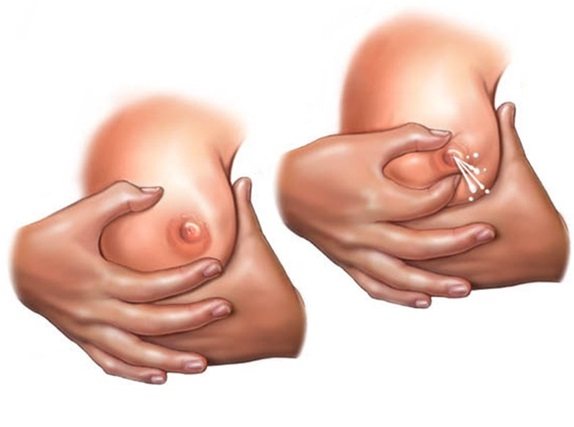
Previously, young mothers were taught that it was necessary to express the rest of the milk after each feeding, “dry” - until the last drop. Now the concept has changed: pumping should only be done under certain conditions:
- if the baby sucks sluggishly, inactive or weak;
- with milk deficiency;
- with excessive production;
- if you need to stock up (travel, medication treatment).
You can perform the manipulation with your hands or use a breast pump; the dishes can be any with a non-slip bottom.
There are several techniques for effectively expressing milk.
Marmet technique. Pumping is performed while sitting, leaning on the back of a chair. You need to hold the milk container with your left hand, grab the gland with your right hand and gently press on the areola with your thumb and forefinger, moving them in the direction of the nipple.
Heated bottle technique. It is recommended to be used when the nipples are too large or tense and the baby cannot fully grasp them. In this case, you need to take a jar with a neck of 4-6 cm, heat the top in hot water, and cool the bottom. The areola should be lubricated with oil and placed in a bottle. The temperature difference will increase the milk and when it begins to come out easily, the bottle must be removed and further expressed by hand.
Breast pump. This device, regardless of design, effectively selects milk with minimal participation from the woman. There is only one subtlety in choosing a breast pump: the diameter of its funnel should be 1-2 cm larger than the diameter of the areola. And during manipulation, the vacuum level must be selected based on personal feelings so that there is no pain or discomfort.
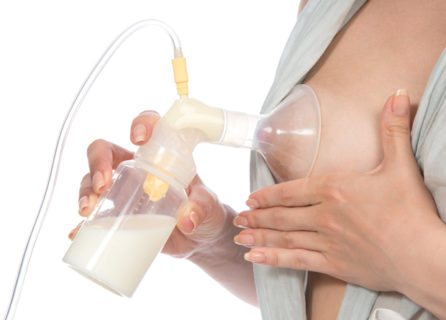
Gymnastic exercises to maintain breast shape
Specialized massage is not recommended for all nursing mothers, but gymnastics is allowed for absolutely every woman. Daily exercises will correct the shape of the mammary glands, strengthen the muscles, and also normalize blood circulation. Moreover, it is better to perform gymnastics even before childbirth, from the last months of pregnancy. After all, the skin must be prepared for lactation, stretching and swelling of the glands. For these purposes, perform the following exercises:
- In a sitting position, fold your hands with your palms facing each other, while your elbows should be at chest level and spread to the sides. Press on your palms 10 times, hold for a while, then relax your hands. With these manipulations, the pectoral muscles are tensed and strengthened.
- Standing on your feet, extend your arms up and cross your fingers. By pressing on the bottom of the palms, the pectoral muscles are strengthened, the tone of the mammary glands increases and the possibility of sagging is reduced.
- Breathing exercises: in a sitting position, cross your legs at the knees (lotus position), with your back straight, place your hands on your knees. Inhale through your nose, while the chest expands and the mammary glands move forward. The spine is in a tense state, and the breath should be as long and deep as possible. Exhaling, relax your body and complete 20 approaches. In addition to maintaining breast shape, breathing exercises calm the nervous system and increase milk production.
Breast manipulation can be both beneficial and increase lactation, and harm the health of a nursing woman. Therefore, when deciding on massage procedures, you should consult your doctor and find out which technique is best to use.
Types and techniques
For self-massage during breastfeeding, consultants recommend several techniques, depending on the location of the discomfort or the problem detected
Using traditional and acupressure techniques, it is important to do the massage correctly, as suggested in the method. These techniques affect areas of muscle tissue and glands, unlike nipple massage, and therefore require accuracy
Traditional
This technique is recommended to eliminate milk stagnation and swelling. It is the swelling that provokes pain, and low passage through the milk ducts leads to inflammatory foci and cystosis in advanced cases.
Correct execution:
- move lightly in a circular motion over the surface of each breast;
- move from the collarbone to the nipple, moving in a spiral;
- stroke in the same direction, but with straight movements;
- With two fingers, gently knead the nipple;
- lean forward, stroking the surface of the chest;
- return to the starting position and repeat the first action.
Finally, rinse your chest with warm water and dry gently with a terry towel without pressing. If you feel acute pain and discomfort during the massage, you need to stop the procedure and consult a doctor!
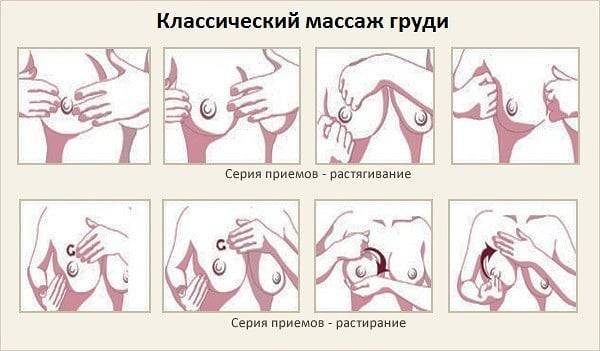
Nipple massage
In the first days of lactation, as well as during hormonal fluctuations, the areolas become rough and do not soften after feeding. It is difficult for a child to latch onto the nipple and extract milk, which is also bad for stimulating lactation - the lower the outflow, the greater the stagnation. This technique relieves swelling and engorgement of the areola, improves the flow of milk for feeding.
Technique:
- connect the ring, middle and index fingers on both hands;
- bend them a little and place them on the chest so that the nipple fits into the resulting window;
- pull the areola slightly up and hold for up to 15 seconds;
- move your hands in a circle around the nipple and pull up the areola on each side;
- Perform one set for each breast.
As a result, the nipple stretches and the area around it softens, making it easier for the baby to latch onto and receive milk.
Acupressure
The acupressure technique is indicated when individual areas of engorgement appear on the chest. Start by stroking from the base to the areolas. Then, when the skin is warm, put your fingers together and lightly press on the area of the lump in a circular motion.
Control the pressure and your sensations. If the process is accompanied by severe pain or shooting, then you should stop the procedure and consult a doctor.
Warm water combined with vibrations that cause diffuse jets can stimulate lactation, reduce swelling and relax muscles. The water should be at a comfortable temperature - you cannot overheat the mammary glands!
Adjust the shower so that the jets are at a low pressure - they should touch your chest pleasantly, but not painfully. Move from the base, from above, to the nipples. At the same time, stroke your chest with your palm after the jets in the same direction.
Then direct the water under your breasts, using a side-to-side boat motion under your areola. Repeat the same movements over the arela. For each breast, massaging for 1-2 minutes is enough.
Massage techniques for breastfeeding will help a young mother keep her breasts in shape, avoid stagnation, mastitis and swelling. This will make breastfeeding painless. At the end of lactation, there will be fewer stretch marks, since the mammary gland will be enlarged evenly.
Prevention of milk stagnation
Preventive measures are not complicated and every woman, using them in full, can avoid lactostasis. The recommendations are:
- positive attitude;
- preparation and regular self-massage of the breast;
- frequent feeding at the baby's request, and not according to the clock;
- duration of feedings - how much the baby needs;
- warm shower before feedings;
- expressing milk as needed;
- a properly selected bra for nursing mothers;
- sufficient drinking regime;
- quality rest and sleep.
A problem such as stagnation of milk in the breast reduces the quality of life of the mother and the nutrition of the baby. If you consistently follow simple rules of prevention, then avoiding lactostasis is not difficult. And if symptoms of stagnation appear, it is best to consult a family doctor or pediatrician and adhere to the prescribed measures - this way, in 2-4 days you can completely return to a healthy state and avoid serious complications.

